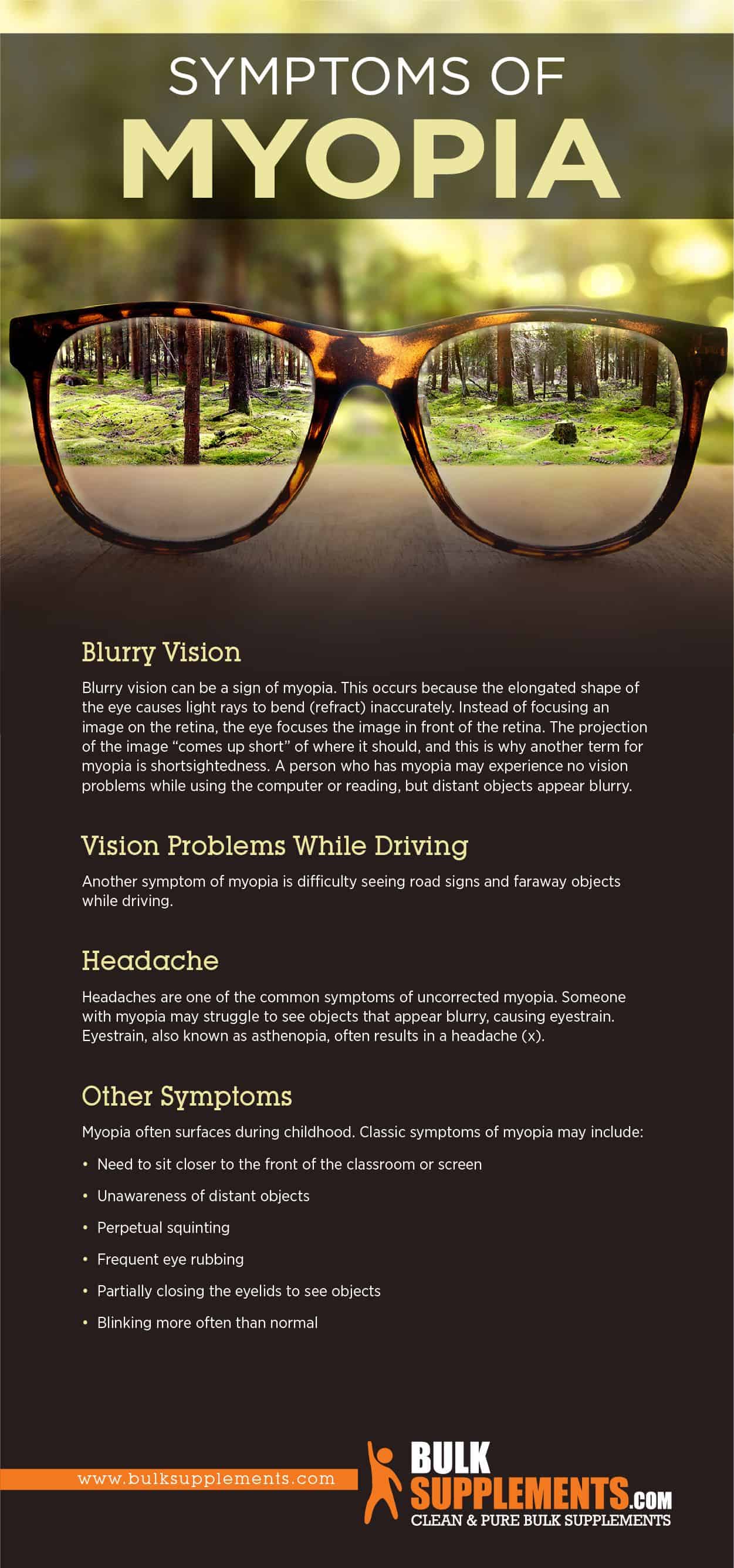Myopia: Symptoms, Causes & Treatment
by James Denlinger Digital Marketing StrategistWhat is Myopia?
Myopia, commonly called nearsightedness, is an eye condition where the light entering the eye focuses in the wrong place, causing images to blur. Someone who has myopia can see things that are close, but cannot clearly see things far away.
The exact cause of myopia is a mystery, but there is significant evidence that people inherit the tendency to have myopia. If one or both parents have myopia, it is more likely that their children will be nearsighted.
Research suggests that people who spend extensive time working at a screen, reading or doing intense visual tasks may be more likely to develop myopia.
Myopia can be diagnosed with a basic eye exam, and although it cannot be cured, a person’s vision can be improved in a variety of ways, including prescription lenses or surgery.
Myopia affects nearly 30 percent of the population in the United States and is a leading cause of vision loss throughout the world.
Symptoms of Myopia
Blurry Vision
Blurry vision can be a sign of myopia. This occurs because the elongated shape of the eye causes light rays to bend (refract) inaccurately. Instead of focusing an image on the retina, the eye focuses the image in front of the retina. The projection of the image “comes up short” of where it should, and this is why another term for myopia is shortsightedness. A person who has myopia may experience no vision problems while using the computer or reading, but distant objects appear blurry.
Vision Problems While Driving
Another symptom of myopia is difficulty seeing road signs and faraway objects while driving.
Headache
Headaches are one of the common symptoms of uncorrected myopia. Someone with myopia may struggle to see objects that appear blurry, causing eyestrain. Eyestrain, also known as asthenopia, often results in a headache.
Other Symptoms
Myopia often surfaces during childhood. Classic symptoms of myopia may include:
- Need to sit closer to the front of the classroom or screen
- Unawareness of distant objects
- Perpetual squinting
- Frequent eye rubbing
- Partially closing the eyelids to see objects
- Blinking more often than normal
 PIN IT
PIN ITCauses of Myopia
Refractive Error
If someone’s eye is elongated, it will cause improper light refraction just short of the retina. This refractive error is myopia. Infants are actually born with a shorter-than-normal eyeball, making them temporarily farsighted. The eye slowly becomes longer until it is completely formed. Researchers are studying this process to determine how much of the eye shaping process is determined by genetics, and how much is determined by early visual experience and other factors.
Lack of Time Outdoors
Studies have shown that intense, natural light can protect against myopia. Global studies have also indicated that myopia is lower in groups of children who spend lots of time outdoors. Scientists are studying the theory that increasing playtime outdoors may help support good vision.
Excessive Reading & Screen Time
Studies have indicated that excessive reading or screen time may contribute to the onset of myopia. There are some theories why this may be true. Some have suggested that myopia progresses because the eye is too fixated for long periods of time without rest. Other scientists say that the visual system is organized into “on and off” pathways. The on pathway encourages proper eye development and the off pathway discourages attention to fine visual details. Researchers assert that black text on a white background stimulates the off pathway.
Myopia Diagnosis and Treatment
A person who experiences vision problems can have a comprehensive eye exam to determine if he has myopia.
Vision Testing
A basic eye exam involves identifying letters on a distance chart, measuring visual acuity. This is recorded as a fraction, such as 20/40. The top number is the distance at which the test is performed (20 feet). The bottom number records the smallest letter size the person has read accurately.
An optometrist may use a handheld retinoscope to measure how the eye focuses light, or an automated instrument that shows how the eye focuses. The optometrist uses the information to diagnose myopia and determine the type of treatment needed.
Treatment Options
There are different ways to correct myopia. An optometrist can help a person choose the best treatment for their unique situation and lifestyle. Treatment options include:
Eyeglasses
This is a common choice for vision correction. Some people may need to wear glasses all the time and some may only need to wear glasses for some activities, such as driving.
Contact Lenses
For some people, contact lenses are the best choice, offering a wider field of view than eyeglasses.
Orthokeratology or CRT
Another option for treating myopia is non-surgical, corneal refractive therapy (CRT) or orthokeratology (ortho-k). This allows the patient to wear a series of special, rigid contact lenses to gradually reshape the cornea, changing the way the eye focuses light. This may be the best treatment for some people with myopia.
Laser Procedures
Laser procedures are also possible options for treating myopia. In this procedure, a laser beam reshapes the cornea by removing a small amount of eye tissue.
Other Refractive Surgery Procedures
People who have severe myopia or whose corneas are too thin for laser procedures may be able to have their myopia corrected by surgery. The doctor can implant small lenses within the eyes, replacing the natural lens or adding the implanted lens in front of the natural lens.
Vision Therapy for People with Stress-Related Myopia
Vision therapy is an option for people whose vision problems are a result of muscle spasms around the eye. Eye exercises can also improve eye focus in some cases.
Related Vision Issues
Myopia vs. Hyperopia
In myopia (nearsightedness), the optical image is focused wrongly in front of the retina, often because the eyeball is longer than normal.
In hyperopia (farsightedness), the received image is focused behind the retina, often because the eyeball is shorter than normal.
Astigmatism vs. Myopia
Astigmatism, like myopia, is caused by a refractive error — the way the eye bends light. Astigmatism occurs when the clear front cover of the eye (cornea, or lens) is irregularly shaped. This prevents light from focusing properly on the retina, causing blurred vision and headaches. Astigmatism can be present along with myopia or hyperopia, and slight astigmatism doesn’t usually affect vision. Astigmatism can be hereditary and may increase or decrease over time.
Presbyopia
Presbyopia is a vision condition where the shape of the eye lens changes, making it difficult to focus on objects at close range. This condition is the result of aging and cannot be prevented. People often notice changes in vision in their 40s, although the changes happen gradually. Signs of presbyopia include blurred vision at a normal reading distance, eye fatigue and headaches. Presbyopia can complicate other vision issues like myopia and hyperopia. People use reading glasses, bifocals or progressive lenses to compensate for presbyopia.
Myopic Degeneration (Pathologic Myopia)
Myopic degeneration (pathologic myopia) occurs when the eye gradually stretches. This causes damage in the retina, the lining of light-sensitive cells in the back portion of the eye. People with severe forms of myopia are at a greater risk for myopic degeneration. A person with myopic degeneration may experience a gradual decrease in central vision, although peripheral vision may not be affected. Myopic degeneration may be hereditary and unavoidable, though early detection and treatment can minimize vision loss.
Night Myopia
Some people only experience blurred vision at night because the low light prevents them from seeing properly, or the increased size of the pupil allows unfocused light rays to enter the eye. This condition is called night myopia. Even people with otherwise perfect vision can have night myopia.
Pseudo-Myopia
People who do a considerable amount of intense, close-up work may have blurry vision due to the overuse of the eye focusing mechanism. The eyes are unable to refocus distances after long periods of work, but after the eyes have rested, clear distance vision returns. However, consistent visual stress over time may lead to permanent vision reduction.
Myopia Remedies and Supplements
Eye Vitamins
Certain health supplements support good vision. These include:
- Vitamin A palmitate is a powerhouse supplement for eye health. Vitamin A can help the eye adjust to changes in light, keep the eyes moist and prevent the formation of cataracts. Recommended dosage: As a dietary supplement, take 30 mg once daily.
- Vitamin C is a super antioxidant that may prevent cataracts and reduce macular degeneration. Recommended dosage: As a dietary supplement, take 1 capsule (750 mg) up to four times daily, or as directed by a physician.
- Zinc is important because it helps convert beta-carotene into usable vitamin A. The eyes need zinc to function properly. Recommended dosage: As a dietary supplement, take 100 mg one to three times daily, or as directed by a physician.
- Eyebright can counteract eye inflammation, tightening the membranes around the eyes while improving circulation in the eye area. Recommended dosage: As a dietary supplement, take 1,000 mg (scant 1/2 tsp) once daily, or as directed by a physician.
Balanced Recreation
Researchers are studying the rising rate of myopia in the younger generation. In fact, findings suggest that use of electronics and fluorescent lighting could be controllable factors in this disturbing trend.
Some recommendations include:
- Avoid use of electronic media before the age of two
- Limit electronic use to one hour a day in children aged two to five
- Children should get 45 minutes of time outdoors each day
- Abstain from electronic devices one hour before bedtime
The Bottom Line
Myopia is a common condition, and there is no widely clear way to prevent or cure it. Heredity plays a part in myopia, and environmental factors may also contribute to its symptoms and progression. A thorough eye examination can determine if a person has myopia, which can be managed in a variety of ways.
Sponsor Ads
Created on Mar 17th 2020 17:30. Viewed 518 times.




